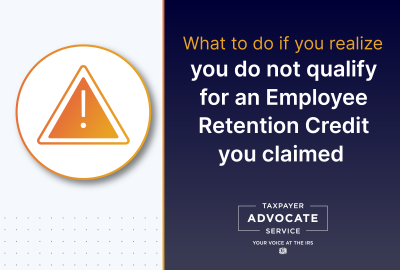

If you have determined you do not qualify for an Employee Retention Credit (ERC) and have not received the refund claimed, you may qualify for the IRS’s ERC withdrawal program.
Taxpayers should carefully follow the special instructions at IRS.gov/withdrawmyERC summarized below.
If you request to withdraw your claim, you’ll be asking the IRS to not process your entire adjusted employment tax return (Form 941-X, 943-X, 944-X, CT-1X) for the tax period that included your ERC claim. Claims that are withdrawn will be treated as if they were never filed. The IRS will not impose penalties or interest. Note, however, that withdrawing a fraudulent ERC claim will not exempt you from potential criminal investigation and prosecution.
If you made any other changes on the adjusted employment tax return or you only need to reduce your ERC claim (not withdraw it entirely), you can’t use the withdrawal process. Instead, you need to amend your return. For more information on these situations, see the Correcting an ERC claim – Amending a return section of the frequently asked questions about the ERC.
IRS.gov/withdrawmyERC provides the following information:
The IRS will send you a letter telling you whether your withdrawal request was accepted or rejected. Your request is not approved until you receive an acceptance letter from the IRS.
If your withdrawal is accepted, you may need to amend your income tax return. See Claiming the ERC for an explanation of how the ERC affects your income tax return.
If your ERC claim has already been paid, you may qualify for the IRS’s ERC Voluntary Disclosure Program (ERC-VDP). The program ends March 22, 2024.
There are several benefits to using the ERC-VDP if you received the ERC but weren’t entitled to it and now want to pay the money back. If you apply to the ERC-VDP:
For information on who qualifies for the ERC-VDP and how to apply see the IRS’ ERC-VDP page.
The IRS will review your application package and verify your eligibility for the ERC-VDP. The IRS will mail you a letter letting you know they received your application and whether they can proceed with your application or if it was rejected.
Tax professionals and others can listen to the recorded:
Nov. 2 IRS webinar, Employee Retention Credit: Latest information on the moratorium and options for withdrawing or correcting previously filed claims.
Feb. 8 IRS Webinar, Employee Retention Credit – Voluntary Disclosure Program (ERC-VDP)
If you are unable to participate in the ERC withdrawal or ERC-VDP but need to make corrections to your return see Q1 and Q2 of the ERC FAQs.